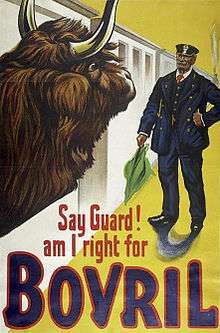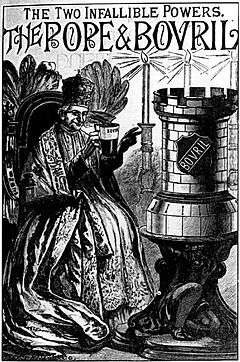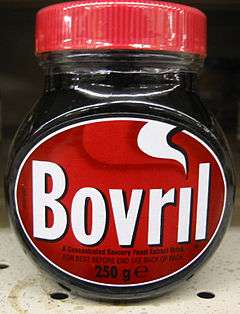Bovril
|
Bovril in the 250 gram jar. | |
| Invented by | John Lawson Johnston (1870) |
|---|---|
| Launch year | 1889 |
| Company | Bovril Company |
| Current supplier | Unilever |
Bovril is the trademarked name of a thick, salty meat extract, developed in the 1870s by John Lawson Johnston. It is sold in a distinctive, bulbous jar. Bovril is made in Burton upon Trent, Staffordshire; owned and distributed by Unilever UK.
Bovril can be made into a drink by diluting with hot water, or less commonly, with milk.[1] It can be used as a flavouring for soups, stews or porridge, or spread on bread, especially on toast in a similar fashion to Marmite and Vegemite.
Etymology
The first part of the product's name comes from Latin bos, meaning "ox". Johnston took the -vril suffix from Bulwer-Lytton's then-popular novel, The Coming Race (1870), whose plot revolves around a superior race of people, the Vril-ya, who derive their powers from an electromagnetic substance named "Vril". Therefore, Bovril indicates great strength obtained from an ox.[2]
History


In 1870, in the Franco-Prussian War, Napoleon III ordered one million cans of beef to feed his troops. The task of providing all this beef went to a Scotsman living in Canada named John Lawson Johnston. Large quantities of beef were available across the British Dominions and South America, but its transport and storage were problematic. Therefore, Johnston created a product known as 'Johnston's Fluid Beef', later called Bovril, to meet the needs of Napoleon III.[3] By 1888, over 3,000 UK public houses, grocers and dispensing chemists were selling Bovril. In 1889, the Bovril Company was formed.
Bovril continued to function as a "war food" in World War I and was frequently mentioned in the 1930 account Not So Quiet... Stepdaughters of War by Helen Zenna Smith (Evadne Price). One account from the book describes it being prepared for the casualties at Mons where "the orderlies were just beginning to make Bovril for the wounded, when the bearers and ambulance wagons were shelled as they were bringing the wounded into the hospital".[4]
A thermos of beef tea was the favoured way to fend off the chill of winter matches for generations of British football enthusiasts; to this day, Bovril dissolved in hot water is sold in stadiums all over the United Kingdom. Bovril beef tea was the main warm drink that Ernest Shackleton's team had to drink when they were marooned on Elephant Island during the Endurance Expedition.[5]
When John Lawson Johnston died, his son George Lawson Johnston inherited and took over the Bovril business. In 1929, George Lawson Johnston was created Baron Luke, of Pavenham, in the county of Bedford.
Bovril's instant beef stock was launched in 1966 and its "King of Beef" range of instant flavours for stews, casseroles and gravy in 1971. In 1971, Cavenham Foods acquired the Bovril Company but then sold most of its dairies and South American operations to finance further take-overs.[6] The brand is now owned by Unilever.[3]
Bovril holds the unusual position of having been advertised with a Pope. An advertising campaign of the early 20th century in Britain depicted Pope Leo XIII seated on his throne, bearing a mug of Bovril. The campaign slogan read: The Two Infallible Powers – The Pope & Bovril.
Licensed production
Bovril is also produced in South Africa by the Bokomo division of Pioneer Foods[7]
During the Siege of Ladysmith in the Second Boer War, a Bovril-like paste was produced from horse meat within the garrison. Nicknamed Chevril (formed by replacing Bo- (Latin bos='ox') with Chev- (French cheval='horse') in the Bovril name) it was produced by boiling down horse or mule meat to a jelly paste and serving it as a beef tea.[8][9]
Recipe changes
Unilever now makes Bovril using beef extract and a chicken variety using chicken extract.[10]
Cultural significance

Since its invention, Bovril has become an icon of British culture. It is commonly associated with football culture, since during the winter British football fans (mainly in local league level or division two) in stadium terraces often drink it from thermoses (or disposable cups in Scotland, where thermoses are banned from football stadiums).[11][12]
During a 2011 episode of Top Gear, James May drank from an urn of Bovril while driving a snowplough in Norway and commented: "We all know that when it's snowing and it's cold you have Bovril. That's a rule of life."[13] Bovril reappeared in another episode of Top Gear in the form of Jeremy Clarkson's V8 Food Blender, wherein it was used to make a "Man's V8 Smoothie" complete with raw beef and brick.
References
- ↑ "Try Bovril and milk (advert),". The Sydney Mail. 1 July 1931. p. 23.
- ↑ Thompson, William Phillips (1920). Handbook of patent law of all countries. London: Stevens. p. 42. Retrieved 2009-08-05.
- 1 2 "Bovril". Unilever.co.uk. Retrieved 12 October 2015.
- ↑ Vivian, Evelyn Charles (1914). With the Royal army medical corps (R.A.M.C.) at the front. Hodder and Stoughton. p. 99.
- ↑ "Shackleton's men kept hope of rescue high; Marooned Scientists, Living on Penguin and Seaweed, Watched Daily for Relief." (PDF). The New York Times. 1916-09-11. Retrieved 2009-05-11.
- ↑ Goldsmith
- ↑ "Pioneer Foods". pioneerfoods.co.za.
- ↑ Watt, S. "Intombi Military Hospital and Cemetery". Military History Journal. Die Suid-Afrikaanse Krygshistoriese Vereniging. 5 (6).
- ↑ Jacson, M (1908). "II". The Record of a Regiment of the Line. Hutchinson & Co. p. 88.
- ↑ "Bovril Unilever food brands".
- ↑ "Bovril: It's a drink, a spread, even a crisp flavouring, and it was created in Edinburgh". The Scotsman. 8 June 2010. Retrieved 20 October 2013.
- ↑ Alexander Lawrie (7 August 2009). "Tribute to Scots Bovril inventor". Deadline News. Retrieved 20 October 2013.
- ↑ "Top Gear: series 16, episode 5". BBC. Retrieved 2011-12-29.
External links
| Wikimedia Commons has media related to Bovril. |
- Official Bovril Website
- Unilever Website
- Unilever explains the reintroduction of beef to Bovril.
- BBC: No beef over Bovril's veggie move
- The Bovril Shrine
